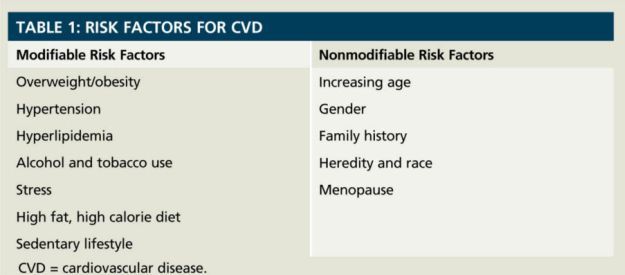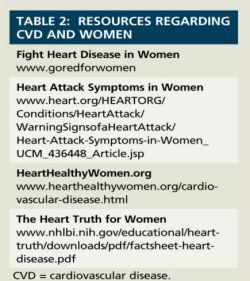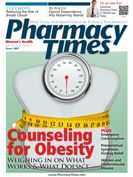Publication
Article
Pharmacy Times
Increasing Awareness About Women and Cardiovascular Disease
Author(s):
Cardiovascular disease, long considered a "man's disease" is a leading cause of death among women.
Cardiovascular disease, long considered a "man's disease" is a leading cause of death among women.
Since 1997, the American Heart Association (AHA) has attempted to increase awareness about cardiovascular disease (CVD) among women. Fortunately, great progress has been made to educate individuals about CVD and its consequences. According to the AHA’s 2011 Guidelines for Prevention of Cardiovascular Disease in Women, the misconception that CVD is a “man’s disease” has been somewhat disproved, as awareness among the general public increased from 30% in 1997 to 54% in 2009.1
Unfortunately, CVD continues to be the leading cause of death in the United States for both men and women.1-4 Since 1984, the number of deaths related to CVD in women exceeded those in men.1-4 In the United States, CVD death rates among women aged 35 to 54 years appear to be increasing by 1% annually, which is most likely attributable to the escalating obesity epidemic.1
According to the AHA, even though CVD is the number 1 cause of death among women, only 13% of women perceive CVD as a health threat.5 CVD is responsible for more deaths among women than the next 3 leading causes of death combined, including all forms of cancer.1
Due to the ongoing prevalence of CVD, increasing awareness and understanding of CVD, especially among the female population, is still a top priority for many health care professionals. As one of the most accessible health care professionals, pharmacists are in a pivotal position to educate and inform their patients on the risks associated with CVD, possible drug therapies, and preventive measures. The AHA has set a goal for 2020 to improve cardiovascular health in all Americans by 20% while reducing deaths from CVD and stroke by 20%.6
Epidemiology and Etiology
According to the American Heart Association, in the United States a woman dies of some form of CVD every minute and more than 1 in 3 females have some form of CVD.2,3
Recognizing Signs and Symptoms of a Heart Attack
Studies have demonstrated that gender differences may play an important role in the diagnosis, treatment, and prevention of CVD.13-15 Unfortunately, many women may not always recognize the warning signs and symptoms of a heart attack because they sometimes appear more subtle when compared with those typically experienced by men.4
Results from a study of 515 women who had heart attacks report that 43% did not experience any type of chest pain or pressure during the heart attack.16 Although the classic symptoms include chest pain, tingling in the left arm, sweating, and shortness of breath, women may also experience some “atypical” symptoms, such as extreme fatigue, nausea, dizziness, indigestion, vomiting, and pain in the neck or back.17-19 By learning and recognizing the warning signs, women can take a proactive approach to their cardiovascular health and get treatment earlier to prevent further complications.
Preventing CVD Through Education and Awareness
When counseling about medications, pharmacists should encourage patients, especially those at risk for CVD, to take a proactive role in achieving and maintaining a healthy lifestyle to protect their hearts. Patients who have already been diagnosed with CVD should be reminded to be compliant with their medication therapy and maintain routine visits with their physician.
Patients, especially those at increased risk of CVD, such as those with untreated sleep apnea, uncontrolled diabetes, hypertension, and polycystic ovarian syndrome, should discuss CVD risk factors with the primary health care provider and address risk factors accordingly. Some risk factors can be found in Table 1.

Through patient education and awareness, many women can greatly decrease the possibility of CVD by knowing their risk factors, family history, the warning signs, and becoming informed about various preventive measures. Many studies have demonstrated that CVD can be prevented or decreased. 20 Results from one study reported that if women adhered to certain lifestyle choices such as diet, exercise, and not smoking, 83% of coronary events might actually be prevented.20
The 2011 updated AHA guidelines for the prevention of CVD in women target areas for prevention, such as specific lifestyle interventions, major risk factor interventions, and preventive drug interventions.1 More in-depth information about these guidelines can be found on the AHA website at http://circ.ahajournals.org/content/123/11/1243.full.pdf.
In 2010, the AHA also introduced a new concept called “Ideal Cardiovascular Health,” which is defined by health behaviors such as nonsmoking, body mass index less than 25 kg/m2 , physical activity at goal levels, and pursuit of a diet complying with current guideline recommendations. It also included adhering to ideal health factors such as untreated total cholesterol less than 200 mg/dL, untreated blood pressure less than 120/80 mm Hg, and fasting blood glucose less than 100 mg/dL.21
Although the statistics regarding CVD, especially among women, are alarming, the good news is that CVD can be decreased or prevented through lifestyle modifications, including eating a healthy balanced diet, regular exercise, maintaining a healthy weight, drug therapy, and by receiving medical intervention when needed in a timely manner. Through knowledge, health care professionals can empower women about the importance of maintaining cardiovascular health and in turn have a profound effect on their overall health.

Ms. Terrie is a clinical pharmacy writer based in Haymarket, Virginia.
References
1. Mosca L, Benjamin EJ, Berra K, et al. Effectiveness-based guidelines for the prevention of cardiovascular disease in women--2011 update: a guideline from the American Heart Association. Circulation. 2011;123(11):1243-1262.
2. Women and Heart Disease. American Heart Association website. www.heart.org/HEARTORG/Advocate/IssuesandCampaigns/QualityCare/Women-and-Heart-Disease_UCM_430484_Article.jsp. Accessed April 27, 2012.
3. Women and CVD statistical fact sheet 2012 update. American Heart Association website. www.heart.org/idc/groups/heart-public/@wcm/@sop/@smd/documents/downloadable/ucm_319576.pdf. Accessed April 27, 2012.
4. Women and heart disease fact sheet. The National Coalition for Women with Heart Disease website. www.womenheart.org/resources/cvdfactsheet.cfm . Accessed April 27, 2012.
5. Mosca L, Ferris A, Fabunmi R, Robertson RM; American Heart Association. Tracking women’s awareness of heart disease: an American Heart Association national study. Circulation. 2004;109(5):573-579.
6. AHA 2020 Goals. American Heart Association website. www.heart.org/idc/groups/heart-public/@wcm/@sop/@smd/documents/downloadable/ucm_319831.pdf. Accessed April 28, 2012.
7. Association of Women’s Heart Programs Final Report. The National Coalition for Women with Heart Disease website. www.womenheart.org/healthCarePro/upload/AWHP_Report_Final-3-11.pdf. Accessed April 29, 2012.
8. Women and Heart Disease Facts. Women’s Heart Foundation website. www.womensheart.org/content/heartdisease/heart_disease_facts.asp. Accessed April 29, 2012.
9. Ob.Gyn. offices ideal for heart risk screening. Internal Medicine News website. www.internalmedicinenews.com/index.php?id=2049&type=98&tx_ttnews%5Btt_news%5D=126986&cHash=da03e20e36. Accessed April 29, 2012.
10. Cardiovascular disease. HeartHealthyWome.org website. www.internalmedicinenews.com/index.php?id=2049&type=98&tx_ttnews%5Btt_news%5D=126986&cHash=da03e20e36. Accessed April 29, 2012.
11. CVD: women’s number one health threat. American Heart Association website. www.heart.org/idc/groups/heart-public/@wcm/@adv/documents/downloadable/ucm_302256.pdf. Accessed April 30, 2012.
12. CVD statistics. American Heart Association Go Red for women website. www.goredforwomen.org/statistics.aspx?id=810. Accessed April 29, 2012.
13. Mikhail GW. Coronary heart disease in women. BMJ. 2005;331:467-468.
14. Mayes G. Do gender differences in heart disease reset the standard of care? Medscape website. www.medscape.com/viewarticle/500667. Accessed April 29, 2012.
15. Robertson RM. Women and cardiovascular disease: the risks of misperception and the need for action. Circulation. 2001;103:2318-2320.
16. McSweeney JC, Cody M, O’Sullivan P, et al. Women’s early warning symptoms of acute myocardial infarction. Circulation. 2003;108:2619-2623.
17. Women and heart disease. CardioSmart American College of Cardiology website. www.cardiosmart.org/HeartDisease/CTT.aspx?id=2638. Accessed April 30, 2012.
18. Milner KA, Funk M, Richards S, et al. Gender differences in symptom presentation associated with coronary heart disease. Am J Cardiol. 1999;84:396-399.
19. Subtle and dangerous: symptoms of heart disease in women. National Institute of Nursing Research website. www.ninr.nih.gov/NR/rdonlyres/054108E8-E4A3-4A09-AA0C-E56D2A09F411/0/NINRHEART1216062508.pdf. Accessed April 29, 2012.
20. Stampfer MJ, Hu FB, Manson JE, et al. Primary prevention of coronary heart disease in women through diet and lifestyle. New Engl J Med. 2000;343:16-22.
21. Jones-Lloyd DM, Hong Y, Labarthe D, et al; American Heart Association Strategic Planning Task Force and Statistics Committee. Defining and setting national goals for cardiovascular health promotion and disease reduction: the American Heart Association’s strategic impact goal through 2020 and beyond. Circulation. 2010;121(4):586-613.







